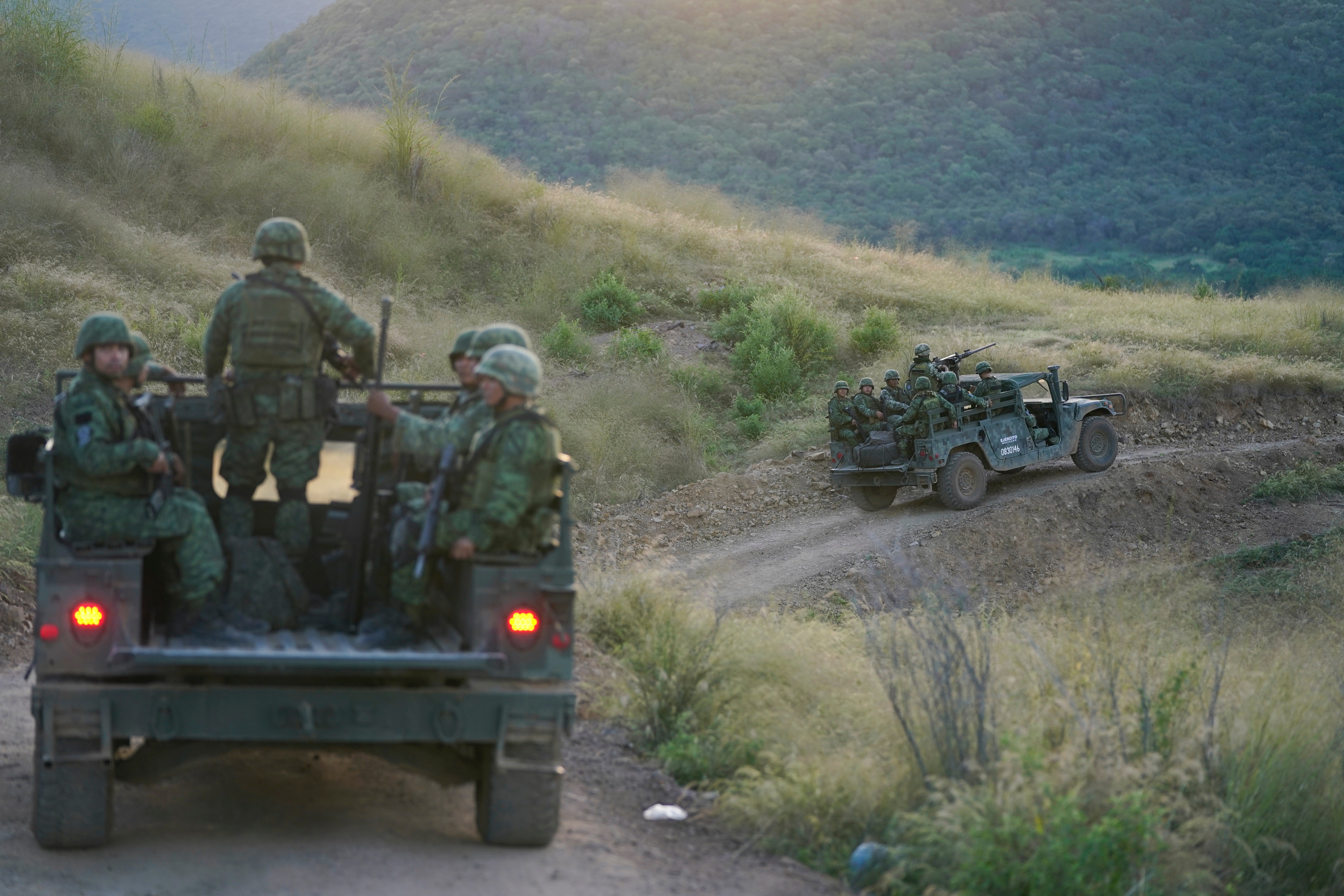Mexican cartels now use IEDs as well as bomb-dropping drones
In the war between drug cartels in western Mexico, gangs have begun using improvised explosive devices (IEDs) on roads to disable army vehicles

Your support helps us to tell the story
From reproductive rights to climate change to Big Tech, The Independent is on the ground when the story is developing. Whether it's investigating the financials of Elon Musk's pro-Trump PAC or producing our latest documentary, 'The A Word', which shines a light on the American women fighting for reproductive rights, we know how important it is to parse out the facts from the messaging.
At such a critical moment in US history, we need reporters on the ground. Your donation allows us to keep sending journalists to speak to both sides of the story.
The Independent is trusted by Americans across the entire political spectrum. And unlike many other quality news outlets, we choose not to lock Americans out of our reporting and analysis with paywalls. We believe quality journalism should be available to everyone, paid for by those who can afford it.
Your support makes all the difference.In the war raging between drug cartels in western Mexico, gangs have begun using improvised explosive devices (IEDs) on roads to disable army vehicles.
The self-defense movement in the town of Tepalcatepec, in western Michoacan state, said improvised land mines severely damaged an army armored car late last week.
A spokesman for the movement, which is battling the Jalisco cartel, supplied photos showing a disabled army light armored vehicle on a road with damage he said was caused by such a mine.
The spokesman, who refused to reveal his name for fear of reprisals, said the explosion happened last Saturday in the town of Taixtan, near Tepalcatepec, where locals have been battling Jalisco gunmen for months.
The warring gangs already frequently use homemade armored cars and drones modified to drop small bombs. But it would be the first time IEDs have been successfully used by cartels in Mexico.
The Mexican Army did not respond to a request for specific comment on the IEDs. But the Defense Department did say army patrols were attacked in the area Saturday four times with explosives, homemade armored cars and gunfire that wounded 10 soldiers. The department did not specify what type of explosives were involved.
The Milenio television station described the IEDs as PVC pipe bombs buried with a round metal base below and a conical metal cap to direct or concentrate the blast.
Security analyst Juan Ibarrola, who specializes in the military, said “the worrisome thing is the improvisation that they (criminal groups) are doing with engineering, to create weapons, boobytraps, explosives and so on.”
Rather than trying to fight an outright war with the army — which they know they would lose — Ibarrola said that with the IEDs and other devices “more than anything else, what they are trying to do is threaten and take on rival groups.”
It is not clear if the improvised land mines are only being used by one side in the bloody turf battle for control of Michoacan state, which drug traffickers value for its seaport and smuggling routes, as well as the opportunity to extort money from the state's growers of avocados and limes.
In November, residents of the Jalisco-dominated village of Loma Blanca showed Associated Press journalists a small crater, with a round metal plate, where they said the Tepalcatepec forces had detonated a land mine.
While cartel gunmen across Mexico have used hand grenades and rocket-propelled grenades against police and soldiers before, IEDs have been practically unknown in the country's drug wars.
In 2010, a car bomb aimed at federal police officers exploded in the northern border city of Ciudad Juarez, killing three people and wounding nine. A drug cartel suspect used a cell phone to set off the explosives-laden car, which killed a federal police officer and two civilians, and wounded nine people.
In 2015, Jalisco cartel gunmen brought down a Eurocopter transport helicopter with a rocket-propelled grenade, killing eight soldiers and a police officer. While the choppers Jalisco faces now are Blackhawks, there is little doubt the cartel can come up with something punchier.
The Mexican government is rapidly running out of tools to control the expansion of the Jalisco cartel, Mexico’s most militarily powerful drug gang. The army has already pulled out some of its most lethal weapons in its fight against the Jalisco cartel: Helicopter gunships equipped with electric mini-guns, rotating barrel machine guns capable of firing thousands of rounds per minute.
But the inhabitants of Michoacan are also fed up with the army’s strategy of simply separating the Jalisco and the Michoacan-based Viagras gang. The army policy effectively allows the Viagras — best known for kidnapping and extorting money — to set up roadblocks and checkpoints on many of the state's roads. Limes, avocados and cattle heading out, or supplies heading in, must pay a war tax to the Viagras.
The do-nothing strategy appears to be part of President Andrés Manuel López Obrador s “hugs, not bullets” policy of avoiding confrontation.
“The difficult thing here is that there hasn't been any resounding effort by the government to confront” the gangs, said Ibarrola. “That's serious, not because there isn't the capacity, the army is there and can do it, but the orders just simply don't come.”
Meanwhile, the cartels have developed bomb-carrying drones, and the most feared warriors are the “droneros,” or drone operators. While initially crude and dangerous to load and operate — and still worrisomely indiscriminate — drone warfare has improved, and it’s not unusual to see metal barn or shed roofs opened like tin cans from the impact of drone explosions.